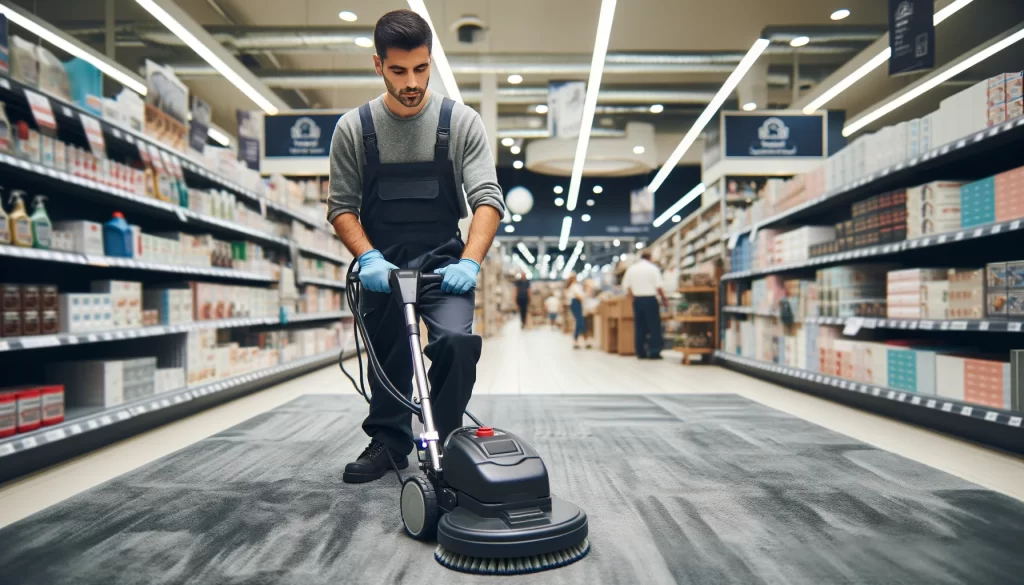Maintaining clean and pristine flooring in a retail environment is crucial for both aesthetic appeal and safety. Retail locations see heavy foot traffic, leading to dirt, grime, and wear that can detract from the overall shopping experience and even pose hazards. For Ruiz Carpet Cleaning, servicing Livermore and Fremont, CA, here are essential tips to keep in mind when cleaning retail flooring.
1. Understand the Flooring Type
Different types of flooring require different cleaning methods and products. Retail spaces may have a combination of carpets, tiles, hardwood, or vinyl. Each type has unique characteristics and cleaning needs:
- Carpets: Require regular vacuuming, spot cleaning, and periodic deep cleaning.
- Tiles: Need sweeping, mopping, and occasionally, grout cleaning.
- Hardwood: Benefits from sweeping, dry mopping, and specific wood-safe cleaning solutions.
- Vinyl: Requires sweeping, mopping, and gentle cleaning solutions to avoid damage.
Understanding the flooring type ensures that the appropriate cleaning techniques and products are used, preserving the longevity and appearance of the floors.
2. Prioritize High-Traffic Areas
Retail locations have high-traffic areas such as entrances, checkout counters, and main aisles that accumulate more dirt and wear. These areas should be cleaned more frequently to maintain a uniform appearance throughout the store. Regular attention to high-traffic zones prevents dirt buildup and prolongs the life of the flooring.
3. Use Commercial-Grade Equipment and Products
Commercial-grade cleaning equipment and products are designed to handle the demands of retail environments. High-quality vacuum cleaners, steam cleaners, and floor scrubbers ensure deep cleaning and effective dirt removal. Additionally, using eco-friendly and non-toxic cleaning solutions is beneficial for the environment and the health of employees and customers.
4. Schedule Regular Deep Cleaning
While daily maintenance is crucial, regular deep cleaning is necessary to address embedded dirt and stains that routine cleaning might miss. Deep cleaning involves using advanced techniques like hot water extraction for carpets or machine scrubbing for hard surfaces. Scheduling deep cleaning during off-hours minimizes disruption to business operations.
5. Implement a Routine Maintenance Plan
Consistency is key to maintaining clean floors. Develop a routine maintenance plan that includes daily, weekly, and monthly tasks. For example:
- Daily: Sweep, vacuum, and spot clean.
- Weekly: Mop hard surfaces and conduct thorough vacuuming.
- Monthly: Perform deep cleaning and inspect for any damages or repairs needed.
A well-structured plan ensures no aspect of floor care is overlooked.
6. Address Spills and Stains Promptly
In a retail setting, spills and stains are inevitable. Promptly addressing these incidents prevents them from setting in and becoming more difficult to remove. Have a protocol in place for staff to quickly clean spills, and keep essential cleaning supplies readily available.
7. Educate Staff on Proper Cleaning Techniques
Training staff on proper cleaning techniques and the use of equipment ensures consistency and effectiveness. Employees should be familiar with the maintenance plan, the correct use of cleaning products, and how to handle emergencies like spills or stains.
8. Consider Professional Cleaning Services
Professional cleaning services bring expertise and specialized equipment to maintain retail flooring at its best. Companies like Ruiz Carpet Cleaning offer tailored solutions for retail environments, ensuring high standards of cleanliness and extending the life of the flooring.
By keeping these tips in mind, retail locations in Livermore and Fremont can maintain clean, safe, and inviting floors that enhance the shopping experience and reflect positively on the business. Investing in proper floor care not only preserves the flooring but also contributes to a healthier and more appealing retail environment.


